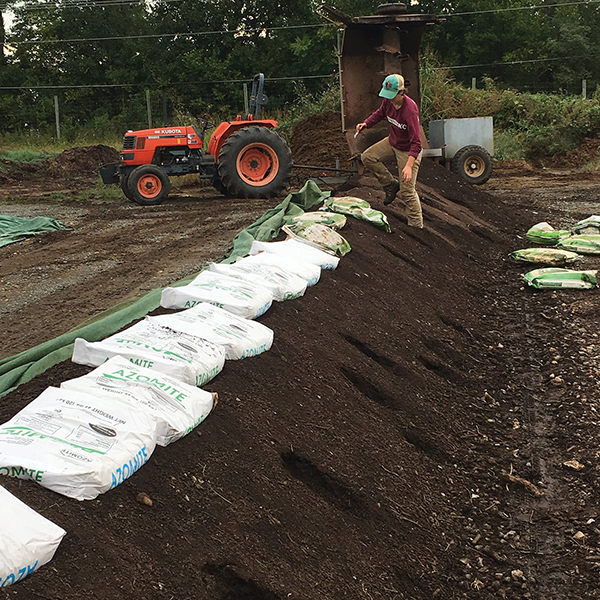
Most people are familiar with basic composting in a bin, but scaling up the process on a hobby farm or homestead offers many more benefits. Large-scale composting allows you to recycle organic waste from your yard, barn, and home to create nutrient-rich “black gold” for your soil.
Why Use Large-Scale Composting?
While small-scale methods like vermicomposting are effective, they may not handle all the organic waste produced on a farm. Large-scale composting ensures no organic matter goes to waste, and the excess material from neighbors can be used as well.
The compost created from this process:
- Enriches soil in raised beds, flowerbeds, and gardens.
- Restores depleted nutrients in garden soil.
- Acts as a natural fertilizer for lawns and pastures, reducing the need for chemical fertilizers.
What is Composting?
Composting is the natural decomposition of organic materials—such as yard waste, kitchen scraps, and barn manure—into a dark, fertile substance known as compost. Microorganisms like bacteria and fungi break down the material, producing nutrient-dense compost.
On a farm or homestead, organic materials for composting may include:
- Carbon-rich materials: leaves, wood ash, straw, sawdust, and tea bags.
- Nitrogen-rich materials: kitchen scraps, fresh lawn clippings, and animal manure (except dog, cat, or human waste due to pathogens).
- Water and oxygen: Both are essential for microorganisms to thrive. Oxygen is introduced by regularly turning the compost pile.
A balanced compost pile aims for a 30:1 ratio of carbon to nitrogen to maintain proper microbial activity.
Types of Large-Scale Composting
Here are four common methods of large-scale composting:
Aerobic Composting
This method relies on oxygen-loving microbes and involves turning the pile every few days to speed up decomposition. It’s ideal for farms as it produces rich compost quickly.Aerated Static Pile
Similar to aerobic composting but requires ventilation pipes to supply oxygen without the need for frequent turning.Anaerobic Composting
This oxygen-free method is slower and often results in foul odors. It is more common in landfills.Windrow Composting
In windrow composting, long rows of organic material are used. This method requires machinery to turn the material and is ideal for commercial-scale operations.
Hot vs. Cold Composting
Compost piles can be either hot or cold, depending on the decomposition temperature.
-
Hot Piles (113°F-160°F): These piles decompose faster and kill weed seeds, pathogens, and insect eggs. Frequent turning ensures even heat distribution.
- Ready in: 4 to 8 weeks.
-
Cold Piles (70°F-90°F): Cold compost piles take longer to break down and are better suited for waste without seeds or pathogens.
- Ready in: 6 to 12 months.
Moisture Management for Compost Piles
Maintaining moisture is key to healthy compost. The moisture content should be between 40-60% for optimal microbial activity.
How to test moisture:
Squeeze a handful of compost from the center of the pile.
- 4-5 drops of water: Ideal moisture level.
- Too wet: Add carbon material and turn the pile.
- Too dry: Add water and green material.
If your compost becomes waterlogged, it may turn anaerobic and develop a foul smell, requiring immediate aeration by turning.
The Importance of Turning Your Compost
Turning the compost pile every 4 to 7 days helps with:
- Aeration: Provides oxygen to microorganisms, preventing bad odors.
- Moisture Control: Redistributes moisture throughout the pile.
- Even Decomposition: Moves outer materials to the center where temperatures are higher.
For large piles, using a tractor or specialized compost turner can make this process easier.
Equipment for Large-Scale Composting
Having the right tools makes large-scale composting more efficient:
- Tractor: Useful for turning the pile and adding new material.
- Pitchfork or Shovel: Essential for manual turning if a tractor isn’t available.
- Wheelbarrow: Convenient for transporting compost and organic materials.
- Compost Thermometer: Helps monitor internal temperatures to ensure ideal conditions.
Where to Store Your Compost
Designating a spot for composting ensures efficient operations. Ideally, your compost site should:
- Be near the garden for easy access to finished compost.
- Have shade to prevent excessive drying.
- Be downwind from your home and neighbors to avoid odor issues.
Pro Tip: Store your compost under trees or close to the barn for easy access with tractors or trucks.
Large-Scale Composting: A Sustainable Solution
Using large-scale composting on your homestead or farm offers numerous benefits:
- Reduces waste: Eliminates the need to haul organic materials to the landfill.
- Nutrient-rich soil: Improves soil health and fertility naturally.
- Cost-effective: Lowers fertilizer costs and minimizes environmental impact.
When managed correctly, large-scale composting turns your organic waste into a valuable resource, creating a sustainable cycle that nourishes your farm for years to come.
With proper moisture, aeration, and turning, your large-scale composting operation will thrive. Whether you use aerobic composting, windrow methods, or a mix of approaches, the results will be the same—nutrient-rich compost that improves soil health and supports sustainable farming.


